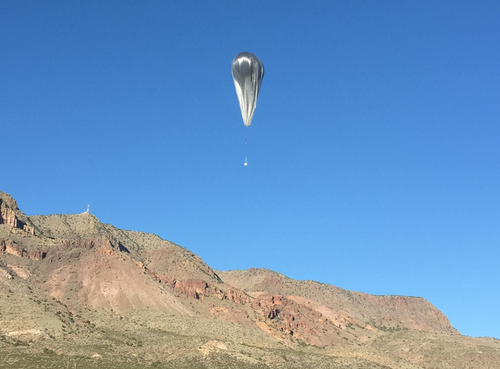Measuring Earthquakes from a Balloon
A balloon doesn’t seem like the ideal tool for a seismologist. But it turns out that earthquakes and other planetary phenomena produce low-frequency sound waves called infrasound that are often best detected from high altitudes. At the American Geophysical Union (AGU) conference in Washington, DC, researchers discussed progress toward a wide range of uses for this technology, from measuring ocean phenomena to detecting “Venus-quakes.”
When the ground shakes, it produces infrasound waves in the air, often at frequencies below 5 Hz. These acoustic waves can travel hundreds of kilometers, and infrasound detection has been an important part of systems for monitoring nuclear tests, along with traditional seismometers. However, ground-based infrasound detectors pick up a lot of wind noise that can overwhelm signals of interest, such as earthquakes, volcano-related ground motion, and even ocean-generated sound waves called microbaroms.
Balloon-borne infrasound detectors (barometers) experience little wind noise because they move with the wind. And they have other advantages: they can detect signals from farther away than ground-based instruments, they can access new environments such as the open ocean, and they benefit from an atmospheric refraction effect that focuses low-frequency sounds upwards.
The US military studied infrasound-detecting balloons in the 1950s and 60s, as a way of monitoring Soviet nuclear tests. But interest didn’t pick up again until about five years ago, when volcano seismologist Jonathan Lees of the University of North Carolina, Chapel Hill, and his then-graduate-student, Daniel Bowman, began testing the technology. Soon the team discovered many nonseismic signals, most of which they could not identify, and they realized that the technique could potentially provide a scientific treasure trove.
At the AGU meeting, Lees, Bowman (now at Sandia National Labs in New Mexico), and their colleagues presented two posters. In one of them, they showed previous data from thunder, a microbarom, and a bright meteor, all identified via their infrasound frequency spectra. They also showed new data from October—the faint signal from wind turbines, detected at an altitude of about 20 km. Bowman believes these data to be “the first time ambient, human-generated sounds have been detected in the stratosphere” since the military work over 50 years ago.
The poster also showed the wide range of signals that one balloon can pick up during 24 hours of flight, many of which are still unidentified. “All these signals here—we don’t know what they are,” says Lees. “That’s pretty exciting,” because there ought to be a lot to learn.
On the other poster, a team led by Attila Komjathy of NASA’s Jet Propulsion Lab (JPL) in California presented progress toward the goal of launching infrasound-sensing balloons in the atmosphere of Venus. Little is known about the planet’s internal structure, but Venus is not exactly seismometer-friendly, with surface temperatures above 460∘C. However, a balloon at 60 km up would experience Earth-like temperatures and pressures, and the famously thick atmosphere means that ground motion would be more easily translated into sound than on Earth.
“If we can see the signal on Earth, and the signal exists on Venus, we are likely to see it on Venus,” says JPL team member Siddharth Krishnamoorthy. But balloons have not yet seen that signal, he says, because they have never detected a natural earthquake. The closest thing so far was a 2017 series of weak earthquakes generated by a 13-metric-ton mass dropped repeatedly at a site in Pahrump, Nevada, where the team’s tethered balloon detected infrasound 300 meters away.
Those measurements also allowed Komjathy and his colleagues to report a new seismic source localization technique: It combines data from two barometers on the same tethered balloon with knowledge of the balloon’s multiple locations (in this case caused by shifting winds). An improved localization technique the team is developing uses a single barometer along with accelerometers, making use of the sudden motion that an acoustic impulse delivers to such a lightweight balloon.
The next test, which could take place in a few weeks, will involve a controlled chemical detonation 300 meters underground, simulating a magnitude 2.5 earthquake at the Nevada National Security Site. The team hopes to detect the infrasound from a free-floating balloon more than a kilometer away and also to track the seismic wave via infrasound as it passes beneath a tethered balloon.
In the near future, Komjathy and his colleagues would like to detect a natural earthquake by flying multiple balloons daily over quake-prone Oklahoma for a couple of months. Preliminary calculations suggest that this campaign will net more than one quake detection per week, and it would provide the team with their closest analog to a Venus-quake.
Once the balloons fly on Venus, researchers will have the challenge of decoding Venusian infrasound data, a long-term process that Lees looks forward to. “Employment for geoscientists for the next, I dunno, 50 years,” he says.
David Ehrenstein is the Focus Editor for Physics.
Sound recorded in the stratosphere, originating from a microbarom, a 0.2-Hz ocean oscillation. The sound is sped up by over 4000 times to make it audible.





